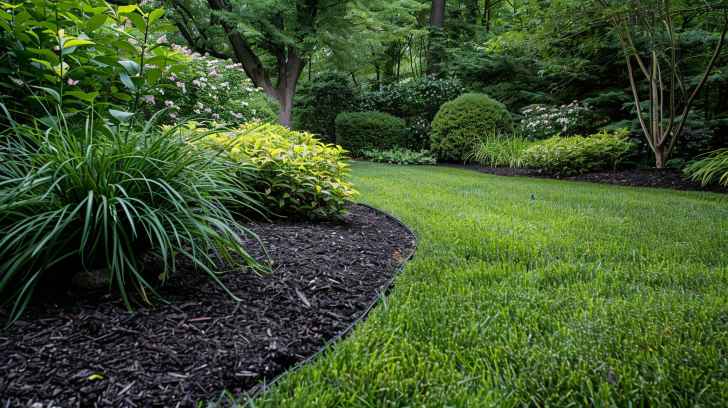Removing trees can be hard and expensive, especially for seniors. Luckily, free tree removal services exist for them. Our article shows ways seniors can remove trees without cost. Keep reading to find out how!
Key Takeaways
- Seniors can get free tree removal services through government programs, insurance companies, and local community help.
- Trading tree removal for wood or using insurance coverage are smart ways for seniors to save money on this task.
- Always check the legitimacy of tree removal offers, especially from door-to-door contractors, to avoid scams.
- Various methods like using Epsom salt or boiling water can effectively remove a tree stump without harsh chemicals.
- To find the best deal on tree removal services, seniors should ask about discounts and compare quotes from multiple companies.
The Importance of Tree Removal for Seniors

Tree removal is vital for seniors because it addresses safety and environmental concerns. Trees that pose a risk by endangering lives or damaging property need to be removed promptly.
Seniors, especially those living alone, must ensure their surroundings are safe from fallen trees that could harm them or damage their homes during storms or due to disease.
Many areas are prone to wildfires, making hazardous tree removal crucial for protecting senior citizens’ homes and properties. Programs exist in states like Hawaii, Illinois, California, and Alabama to help with this task.
Ensuring these dangerous trees are removed can significantly decrease the threat of wildfires spreading near homes, offering peace of mind and enhancing fire protection efforts for seniors’ residences.
Government-Backed Free Tree Removal Services for Seniors

Many government agencies and non-profit organizations offer free tree removal services for seniors, aiming to enhance safety and property maintenance. The US Department of Agriculture, under the Farm Bill Act of 2014, mandates assistance particularly for farmers but also extends benefits to senior citizens in need.
This initiative helps prevent potential damage from fallen trees and reduces wildfire risks. Area Agencies on Aging Offices across several states provide similar support, focusing on helping elderly homeowners keep their properties safe and manageable without the financial burden.
In states like Hawaii, Illinois, California, and Alabama, specific programs are tailored to assist seniors with tree removal. These services understand the unique needs of older adults who may face challenges in maintaining their outdoor spaces due to physical or financial constraints.
By removing hazardous trees at no cost, these programs significantly lower the threat that such trees pose during storms or wildfires while ensuring seniors can enjoy a safer living environment.
Engaging with these services often requires reaching out to local government offices or non-profit organizations committed to aiding senior citizens in this essential aspect of home maintenance.
Steps Involved in Tree Removal
Tree removal is vital for your safety and to maintain a healthy landscape. Here are the steps involved:
- Evaluation – An arborist assesses the tree’s health, size, and location. This step determines if removal is the best option.
- Getting permits – Some areas require a permit to cut down trees. Check with your local government or a professional to ensure you’re following rules.
- Clearing the area – Before work starts, remove any obstacles that might hinder safe removal.
- Cutting strategy – The arborist decides whether to cut the tree in sections or fell it in one piece, depending on space and safety.
- Felling the tree – Workers safely cut down the tree, using ropes and harnesses if needed.
- Limb removal – After felling, they remove branches from the main trunk.
- Cutting the trunk – The trunk gets cut into manageable pieces for easier removal or processing.
- Stump grinding – The remaining stump can be ground down to prevent it from becoming a hazard.
- Cleanup – Workers collect all debris, leaving your yard clean and safe.
Each step is crucial for a smooth and safe tree removal process.
Specific Free Tree Removal Options for Seniors
Seniors have several ways to remove trees for free, making it easier and safer for them. These options include help from insurance companies, trading services, neighborly assistance, and removal of trees on public lands.
Assistance from Insurance Companies
Insurance companies can be a big help with tree removal for seniors. If trees are covered under your homeowners insurance, you might get the service for free. This is because some insurers provide special coverage for seniors that includes tree removal.
Always check your policy or talk to your agent to see if this benefit applies to you.
Getting assistance from insurance can save money and ensure safety. If a fallen or damaged tree threatens your property, contact your insurer right away. They will guide you through the process and may cover the costs if it aligns with your policy terms.
This way, you stay safe without worrying about high expenses.
Barter System Approach
The barter system approach offers a unique way for you to handle tree removal without opening your wallet. You can trade something you have, like the chance to keep logs for firewood, in exchange for getting those troublesome trees taken down.
This method requires some negotiation but can lead to free or significantly reduced costs. Small companies might be more open to such deals, allowing both parties to benefit.
You also have the option of taking care of the green waste yourself or agreeing to leave the stump in exchange for free tree removal. These options provide practical solutions that meet your needs while helping you save money.
It’s a smart move—leveraging what you already have or can do—to tackle tree removal efficiently.
Help from Neighbors
Neighbors can be a great resource for seniors who need help with tree removal. Local neighborhood networks often connect seniors with community members willing to lend a hand or share information about free services.
Friends next door might know about local volunteer groups focused on helping seniors with such tasks. They could even offer personal assistance, making the chore easier and safer for older adults.
Community organizations sometimes provide support through volunteer programs specifically designed for assisting seniors in maintaining their yards and removing trees. By reaching out to neighbors, many seniors find unexpected resources and gain access to valuable assistance.
This neighborly support not only aids in managing tree problems but also strengthens community bonds, ensuring older individuals feel supported within their local environment.
Removal of Trees on Public Property
For seniors living near public property, it’s good to know that local governments often handle tree removal. This is especially true for trees that pose a danger or are dying. If you notice such a tree near your home, contacting city officials is a smart move.
They can assess the situation and remove the tree if needed.
Cities offer these services to keep everyone safe. Make sure you reach out early if you see a problem tree on public land. The process might take some time as it involves assessment and scheduling.
Your safety and that of the community are top priorities for local authorities.
Free Tree Removal in Exchange for Wood
Some companies will remove your tree for free if they can keep the wood — a win-win for those who need space and want to save money. Keep reading to discover how this might work for you.
Who Offers this Service?
Local governments, utility companies, and home insurance providers often offer free tree removal services. They aim to help seniors keep their property safe and clear of potential hazards.
For instance, if a tree threatens the safety of power lines, utility companies might remove it at no cost. Similarly, cities and towns may have programs to take down trees that could become dangerous during storms or other severe weather conditions.
Insurance companies sometimes cover the expense when a tree poses a risk to your house or is already causing damage. These services are part of efforts to reduce claims from accidents and maintain community safety.
It’s crucial to check with your insurance agent about what your policy includes regarding tree removal. Also, exploring local government websites can provide information on available assistance programs for seniors needing tree removal services without any charge.
Factors to Consider
Trading tree removal for wood is a smart move. It helps keep your property safe and tidy. Here are key points to think about:
- The type of tree matters. Hardwoods like oak or maple can fetch a better exchange value than softer woods such as pine.
- Size and condition of the tree play a big part. Larger trees offer more wood, but if they’re diseased, it lowers their worth.
- Gather multiple offers. Don’t settle on the first service provider you talk to. Compare deals from different companies.
- Look into the company’s background. Choose someone with good reviews and proper insurance to avoid any liability on your part.
- Understand the process. Ask how they’ll remove the tree and what equipment they’ll use, ensuring minimal damage to your property.
- Discuss cleanup plans. Make sure they include removing the stump and clearing away debris in their service.
- Consider timing. Removal during off – peak seasons might get you a better deal.
- Check for permits. Some areas require permits for tree removal, so confirm who handles this aspect – you or the company.
Keep these factors in mind to make informed decisions about exchanging free tree removal for wood services.
Types of Trees Suitable for this Exchange
Certain trees are more valuable for wood exchange. Hardwoods like oak, maple, and cherry often catch the eye of professionals. These trees produce high-quality timber, making them top picks.
Softwoods such as pines and cedars also hold value but differ in uses and appeal.
Exotic trees like mahogany and rosewood bring a premium due to their rare wood. Landscapers might especially seek these out for unique projects. Always check with local services to see which types they prefer.
This ensures your tree removal aligns with what’s in demand.
Tree Removal Service That Pays You
Some tree removal services offer to pay you for trees they remove from your property. This can happen if the trees are valuable for timber or specialty wood products. Services assess the tree’s type, health, and size before deciding if it’s worth more than the cost of removal.
You could earn money while solving your tree problem.
Before agreeing to this service, ask about their assessment process and what happens after they remove the tree. Make sure you understand how much you will get paid and when. This option can turn a necessary chore into a profitable opportunity, especially with larger or rarer trees on your land.
Effective Ways to Remove a Tree Stump
Removing a tree stump can seem tough. Yet, simple methods like Epsom salt can break it down, making removal easier.
Using Epsom Salt
Epsom salt helps kill tree stumps effectively. You simply need to drill holes into the stump and pour in the Epsom salt. Make sure these holes are deep for better absorption. Over time, the salt dehydrates the wood, which causes it to decompose naturally.
This method avoids harsh chemicals, making it a safe choice for your garden.
Keep applying Epsom salt every few weeks to ensure success. The process might take a bit of patience as decomposition speeds can vary based on the size and type of tree stump. With consistent application, you’ll notice the stump breaking down, eventually making it easy to remove or leave as it turns into mulch over time.
Using a Plastic Bag or Tarp
Covering a tree stump with a plastic bag or tarp is an easy way to deal with it. This method blocks sunlight and rain, which helps kill the stump faster. Make sure the plastic or tarp is secure by placing rocks or heavy objects around its edges.
Over time, this lack of elements slows down the growth of new shoots and starts the decomposing process.
Keep checking on it regularly. You might need to add more weight if the wind blows the cover off. The goal is to keep it dark and dry under there, speeding up when the stump breaks down into soil.
This method doesn’t require harsh chemicals, making it a safer choice for you and your garden.
Using Boiling Water
Pour boiling water over the tree stump to kill it. This method is simple and effective for seniors. You need a pot of water brought to a boil. Then, carefully pour the hot water over the stump.
The heat helps break down the wood, making it easier to remove.
Repeat this process several times until you see progress. The boiling water speeds up decomposition of the stump, saving time and effort in removal efforts. This technique avoids heavy machinery or chemicals, making it safe and eco-friendly for home use.
Conclusion
Finding the right tree removal service doesn’t have to be hard for seniors. With many options available, from government programs to neighborhood help, there’s always a way to keep your yard safe and tidy.
Don’t forget; some services might even pay you or offer the work for free in exchange for the wood. Stay informed, explore your options, and enjoy a beautiful, hazard-free outdoor space without breaking the bank.
FAQs
1. What are free tree trimming services for seniors?
Free tree trimming services help seniors maintain their yards by cutting branches and removing dead trees, ensuring health and safety without any cost.
2. Why is tree trimming important?
Trimming trees keeps them healthy, prevents damage from falling limbs, and protects homes — especially in areas facing the climate crisis.
3. Can anyone trim my trees for free?
Not everyone can trim your trees safely; look for services with liability insurance and workers’ compensation to protect yourself.
4. How does planting new trees benefit seniors?
Planting trees like the western red cedar or conifers improves air quality and supports the environment — a crucial step against the climate crisis.
5. Should I check a service’s credentials before they trim my trees?
Yes, always check with organizations like the Better Business Bureau to ensure trustworthy and reliable service for your peace of mind.






